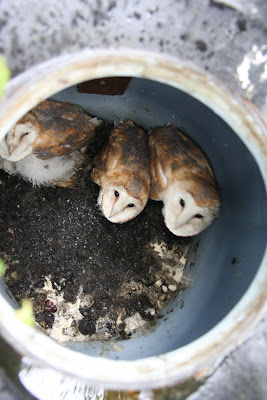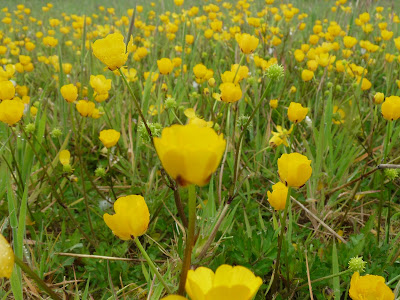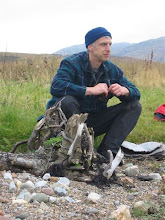



As you can see, we have sheep on the Moss. This rather motley crew are part of the Scottish Wildlife Trust flying flock, a group of sheep that are not quite as exciting as their name but they are moved around to undertaken habitat maintenance at a number of conservation sites. So for July till September we are hosting 40 different coloured sheep whose job is to nibble as much birch trees as possible hopefully killing them (the birch not the sheep).
We know from old documents that sheep grazed Flanders Moss for hundreds of years up until the early 1800s. This combined with burning of heather probably kept Flanders free of trees for much of its life. The trees only invaded when grazing and burning no longer happened on the Moss. So what we are doing is bringing back a traditional form of management. However unfortunately we can't just replicate the old management just how it used to be. For a start young children used to herd the sheep out onto the Moss and then keep an eye of them for the day and then bring them back to the farms in the evening. Welfare issues rule out this management option these days unfortunately (though my daughter would happily do this for pocket money and to get out of chores and school). Also the sheep of today are mostly not up to grazing anywhere as tough as the Moss. So what we have to do now is to get in special sheep breeds that can withstand the hard grazing and wet conditions. The flying flock are mainly Shetland sheep who think Flanders is a breeze compared to where they come from. The sheep have to be fenced onto the Moss as if unattended they would naturally head for the better grazing in the arable fields surrounding the moss, something our neighbours wouldn't approve. For animal welfare reasons we also need to check the sheep 4 or 5 times a week to make sure they fit and healthy and all present. In the old days this activity was called "lookering", a good name for sheep checking. You would think counting 40 sheep was an easy job but this activity is hard work as these sheep don't like making things easier for the counter. Firstly they hide in the grass. When finally discovered they then mill around, hiding behind each other and generally make it difficult to be counted. And then they burst off across the Moss and try to sneak back to be double counted. But despite this there are signs that the sheep are starting to do their job and all the time the do theirs I am happy to "looker".



























